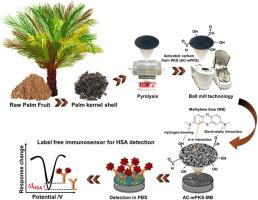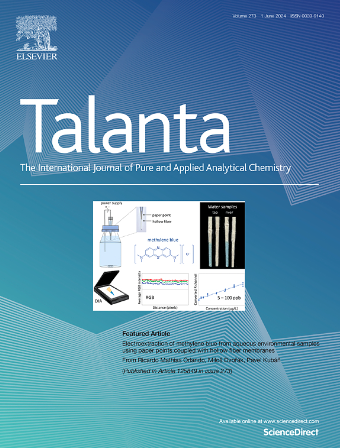以废棕榈仁壳为原料,利用球磨技术合成活性炭,制备了一种经济实惠的无标签免疫传感器,用于HSA检测
IF 6.1
1区 化学
Q1 CHEMISTRY, ANALYTICAL
引用次数: 0
摘要
从棕榈油工业的副产品棕榈仁壳(PKS)中生成活性炭(AC)可以通过多种工艺实现,包括热解和活化(KOH湿法)。通过球磨控制废PKS (wPKS)的粒度,使AC-wPKS表面积最大化。采用循环伏安法、扫描电子显微镜(SEM)、傅里叶变换红外光谱(FTIR)、拉曼光谱(Raman)、布鲁诺尔-埃米特-泰勒(BET)分析和场发射透射电子显微镜(FETEM)等手段对AC-wPKS的电化学和形态特性进行了全面研究。将AC-wPKS上的含氧官能团与亚甲基蓝(MB)连接,制备了一种检测人血清白蛋白(HSA)的无标记免疫传感器(抗体-抗原相互作用)。采用差分脉冲伏安法(DPV)检测免疫传感器的分析性能,包括线性、重现性、储存稳定性和选择性。AC-wPKS: mb修饰的丝网印刷碳电极成功检测血清样品中的HSA,可接受的回收率为84±1 ~ 101.2±0.4%。这项研究强调了棕榈油生产废物作为石墨类材料可持续来源的潜力,不仅为电化学传感提供了一种新的方法,而且还提供了一种有效的废物管理策略。本文章由计算机程序翻译,如有差异,请以英文原文为准。

An affordable label free immunosensor based on activated carbon synthesized from waste palm kernel shell with the aid of ball milling technology for HSA detection
The generation of activated carbon (AC) from palm kernel shells (PKS), a by-product of the palm oil industry, can be achieved through various processes, including pyrolysis and activation (KOH wet method). The particle size of waste PKS (wPKS) was controlled through ball milling to maximize the surface area of AC-wPKS. The smallest particle size, 189 nm, was achieved after ball milling for 24 h. The electrochemical and morphological properties of AC-wPKS were thoroughly investigated using a combination of cyclic voltammetry, scanning electron microscopy (SEM), Fourier transform infrared (FTIR) spectroscopy, Raman spectroscopy, Brunauer-Emmett-Teller (BET) analysis, and field emission transmission electron microscopy (FETEM). Oxygen-containing functional groups on AC-wPKS were linked with methylene blue (MB) to develop a label-free immunosensor (antibody-antigen interaction) for human serum albumin (HSA) detection. The analytical performance of the immunosensor, including linearity, reproducibility, storage stability, and selectivity, was examined using differential pulse voltammetry (DPV). The AC-wPKS:MB-modified screen-printed carbon electrode successfully detected HSA in blood serum samples with acceptable recovery rates ranging from 84 ± 1 to 101.2 ± 0.4 %. This study highlights the potential of waste from palm oil production as a sustainable source of graphite-like material, offering not only a novel approach for electrochemical sensing but also an effective waste management strategy.
求助全文
通过发布文献求助,成功后即可免费获取论文全文。
去求助
来源期刊

Talanta
化学-分析化学
CiteScore
12.30
自引率
4.90%
发文量
861
审稿时长
29 days
期刊介绍:
Talanta provides a forum for the publication of original research papers, short communications, and critical reviews in all branches of pure and applied analytical chemistry. Papers are evaluated based on established guidelines, including the fundamental nature of the study, scientific novelty, substantial improvement or advantage over existing technology or methods, and demonstrated analytical applicability. Original research papers on fundamental studies, and on novel sensor and instrumentation developments, are encouraged. Novel or improved applications in areas such as clinical and biological chemistry, environmental analysis, geochemistry, materials science and engineering, and analytical platforms for omics development are welcome.
Analytical performance of methods should be determined, including interference and matrix effects, and methods should be validated by comparison with a standard method, or analysis of a certified reference material. Simple spiking recoveries may not be sufficient. The developed method should especially comprise information on selectivity, sensitivity, detection limits, accuracy, and reliability. However, applying official validation or robustness studies to a routine method or technique does not necessarily constitute novelty. Proper statistical treatment of the data should be provided. Relevant literature should be cited, including related publications by the authors, and authors should discuss how their proposed methodology compares with previously reported methods.
 求助内容:
求助内容: 应助结果提醒方式:
应助结果提醒方式:


